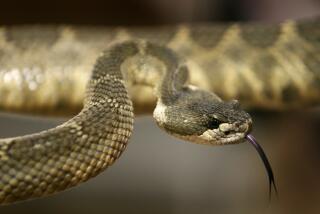ORANGE : Snake Lover Battles to Keep B.C.
- Share via
Mike Courtney is wrapped up in snakes.
When he was 9, his father brought him his first baby boa, a two-foot red-tail tucked in a tennis shoe. When he served in Vietnam in 1970, he became caretaker of the company mascot, a reticulate python.
Courtney, 41, a painting contractor, has owned pythons and boas all his life and says big snakes have been given a bad name.
“The snake is a very misunderstood creature,” Courtney said. One reason is that “the only form of communication they have is a hiss. You can’t determine whether it’s a good hiss or a bad hiss. They all sound derogatory.”
It is this lack of understanding, Courtney says, that recently led the city to ask him to get rid of his 11-year-old pet boa constrictor, B.C. Courtney bought B.C. seven years ago, but last fall someone reported the snake to code enforcement officials. About 10 feet long, the Colombian red-tail is four feet longer than city animal ordinances allow.
Despite B.C.’s size, the snake poses no threat to the neighbors in the 10-unit apartment complex, Courtney said. Boas are docile by nature, he added. Courtney is seeking a variance to the ordinance that will allow him to keep B.C. If Courtney can show that the snake is safely contained, he will probably be awarded the variance, a code enforcement spokeswoman said.
Some tenants in Courtney’s building said they didn’t know about B.C. and expressed mixed feelings about the boa next door.
“As far as whether (Courtney) is qualified to handle the snake, I have to say he is,” said one tenant who asked not to be identified. “But if you ask me if I want a snake as a neighbor, I’d rather not.”
He added that if the snake escaped, “someone could lose a cat.” Another neighbor wondered if the snake could choke her or harm children at a nearby preschool.
Experts say these fears are largely unfounded.
A boa could “eat a kitten and a puppy, but it’s not going to seek them out,” said Harvey Fischer, curator of reptiles at the Los Angeles Zoo. “It’s an opportunistic feeder.”
Courtney feeds B.C. one live rabbit each month. Boas are nonpoisonous and kill their prey, usually rodents or rabbits, by coiling around the animal until it suffocates. They swallow their prey whole.
“I’ve never heard of a boa causing anybody any grief. I do have a few python stories,” Fischer said, referring to a larger, more dangerous snake.
Courtney says many snake owners are violating city code. He wants the ordinance revised to consider individual species.
“If I could do something so other snake owners could just come out of the woodwork instead of having (snakes) illegally, it would help,” Courtney said.
More to Read
Sign up for Essential California
The most important California stories and recommendations in your inbox every morning.
You may occasionally receive promotional content from the Los Angeles Times.













